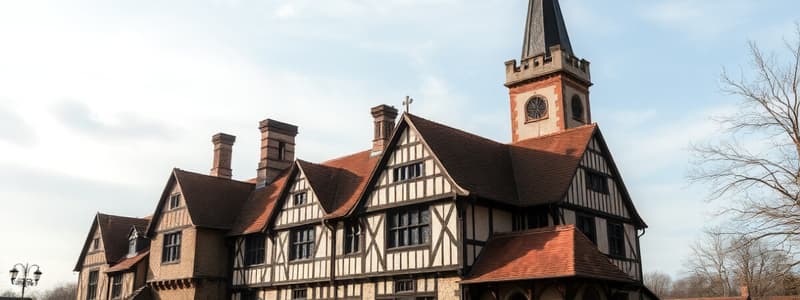Podcast
Questions and Answers
What was Elizabeth's title in relation to the Church of England?
What was Elizabeth's title in relation to the Church of England?
- Archbishop
- Pope
- Supreme Head
- Supreme Governor (correct)
The religious practices under Elizabeth were completely identical to those of the Catholic Church.
The religious practices under Elizabeth were completely identical to those of the Catholic Church.
False (B)
What was the primary aim of Elizabeth's Religious Settlement?
What was the primary aim of Elizabeth's Religious Settlement?
To ease religious tensions and compromise between Protestant and Catholic factions.
Elizabeth's Religious Settlement was established in ______.
Elizabeth's Religious Settlement was established in ______.
Match the following historical figures with their religious affiliations:
Match the following historical figures with their religious affiliations:
Which term was avoided by Elizabeth in her title regarding the church?
Which term was avoided by Elizabeth in her title regarding the church?
The English monarch was recognized as the spiritual authority in the Church of England.
The English monarch was recognized as the spiritual authority in the Church of England.
What significant consequence did denying Elizabeth's position in the Church carry?
What significant consequence did denying Elizabeth's position in the Church carry?
The established religion under Elizabeth was ______.
The established religion under Elizabeth was ______.
What did Elizabeth retain in the practices of the Church of England to please her subjects?
What did Elizabeth retain in the practices of the Church of England to please her subjects?
What was one of the challenges Elizabeth faced even after the Religious Settlement was enacted?
What was one of the challenges Elizabeth faced even after the Religious Settlement was enacted?
Flashcards
Elizabethan Religious Settlement
Elizabethan Religious Settlement
The official religion of England under Elizabeth I, which retained some Catholic traditions but established the monarch as the head of the Church.
Protestantism
Protestantism
The beliefs and practices of the Christian church that broke away from the Roman Catholic Church during the Reformation.
Catholicism
Catholicism
The Christian Church in Western Europe before the Reformation, where the Pope holds the highest authority.
Holy Communion (or Mass)
Holy Communion (or Mass)
Signup and view all the flashcards
Vestments
Vestments
Signup and view all the flashcards
Supreme Governor
Supreme Governor
Signup and view all the flashcards
Oath of Loyalty
Oath of Loyalty
Signup and view all the flashcards
Revised Prayer Book
Revised Prayer Book
Signup and view all the flashcards
Religious Settlement Laws
Religious Settlement Laws
Signup and view all the flashcards
Elizabeth's 'Middle Way'
Elizabeth's 'Middle Way'
Signup and view all the flashcards
Study Notes
Religious Settlement in Elizabethan England
- Religious divisions arose in England due to Protestant challenges to the Catholic Church's dominance.
- Elizabeth I sought a "middle way" to avoid religious extremism.
- The established religion was Protestant, rejecting Papal authority (Catholics acknowledged the Pope's leadership).
- The English monarch, not the Pope, was the head of the Church of England.
- Religious practices in the Church of England retained some Catholic traditions (e.g., Mass, vestments).
- Elizabeth's Religious Settlement (1559) included two laws:
- Elizabeth as Supreme Governor of the Church (avoiding "Supreme Head" as Christ was seen as head).
- Prohibition of foreign leadership in the English church; denying Elizabeth's position was treason.
- The settlement established Protestantism as the official faith and set out rules for religious practice in a revised prayer book.
- The settlement included elements from both Protestantism and Catholicism to appease both groups.
- The settlement was largely supported, with few refusing the loyalty oath.
- Opposition existed, not just from Catholics, but also more extremist Protestants (Puritans), who opposed compromise.
Studying That Suits You
Use AI to generate personalized quizzes and flashcards to suit your learning preferences.




